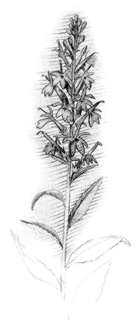 Fires
Creek
Fires
Creek  Fires
Creek
Fires
Creek [Fig. 32(16)] Serious outdoors lovers take note: The Fires Creek area—tucked away in the extreme southwest corner of North Carolina amid some of the most remote and pristine scenery in the eastern United States—offers varied opportunities for superb interaction with the natural world. Its more than 21,000 acres, which shelter abundant flora and fauna, are ideal for hiking, backpacking, camping, hunting, and fishing.
The most unusual geological feature in Fires Creek is the "bowls" or basins occurring atop Potrock Bald (reached via the Trail Ridge Trail from Bristol Horse Camp). Local legend says these unique depressions, of uncertain origin, were used by the Cherokee, perhaps for cooking. A similar (and more easily reached) formation is the Indian Wash Pot on the bank of Fires Creek near Leatherwood Falls. Supposedly, the Indians used it to heat water for bathing, though it's now filled in with leaves and debris. The falls themselves, about 35 feet high, make a pleasant picnic spot. In addition to the usual southern Appalachian hardwoods, six kinds of pine, hemlock, mountain laurel and rhododendron, ferns, and a dazzling array of wildflower species thrive here.
Fires Creek is a designated bear sanctuary, and as development in surrounding areas limits their habitat, still more black bears (Ursus americanus) will be driven into this protected territory. The rare Appalachian water shrew (Sorex palustris) can be seen in the fast-moving, high-elevation streams, as can the southern pygmy shrew (S. hoyi). Other local fauna include all the small game typical of the area: squirrels, wild turkey (Meleagris gallopavo), white-tailed deer (Odocoileus virginia), and ruffed grouse (Bonasa umbellus), as well as both copperhead (Agkistrodon contortrix) and timber rattlers (Crotalus horridus). The pristine streams shelter native brook trout, rainbow trout, and brown trout. Among the many bird species here are numerous varieties of warblers, hawks, owls, and woodpeckers.
The Rim Trail, a roughly 26-mile loop, circumscribes the Fires Creek basin, intersecting with other shorter trails en route. Although many more equestrians than hikers use the trail, backpackers could spend several pleasurable days exploring the loop. Camping is prohibited in designated wildlife openings. And, as always along ridgeline trails, hikers are advised to carry plenty of water (though, at 8 pounds per gallon, it makes its presence felt in a backpack). There is a dependable spring near the intersection of the Shinbone Ridge and Rim trails, about 100 feet below the rim, and several other springs that may require a longer detour to reach.
 Leatherwood
Falls
Leatherwood
Falls [Fig. 32(15)] Heading west from Transylvania, Macon, and Jackson counties, the number of waterfalls drops off as precipitously as the hundreds of cascades left behind. The reason for this drastic change is found in the geology rather than in factors such as amount of rainfall. (Clay County, for example, does experience a somewhat reduced amount of rainfall, but not enough to be the cause of this difference.) Here, as in the Great Smoky Mountains, more sedimentary rock is present. Unlike the harder, more erosion-resistant metamorphic and igneous rock in the regions to the east and north, sandstone does not hold up as well to weathering and wear. The water wears the rock down instead of creating dramatic cascades. In addition, without the higher elevation plateaus found farther east, streams do not have time to become wide and strong enough to form waterfalls before they flow into the valleys.
Nonetheless, Leatherwood Falls in Clay County is a beautiful, if less dramatic, example of nature and gravity. Leatherwood Falls is located in the Fires Creek Recreation Area, part of the Nantahala National Forest. The 25-foot falls is visible from the picnic area or along a barrier-free, paved trail alongside the creek. The ice-cold water of Fires Creek provides an invigorating swim for hearty souls, particularly under the bridge where it is 6 or 7 feet deep. Leatherwood is a common family name in the area, and generations of local children have frolicked in the creek or fished for trout along its banks.
Colorful wildflowers are everywhere, and huge mossy logs, remnants of the once-abundant chestnut tree, add to the beauty. For a short walk, the .7-mile loop trail along the creek is easy and enjoyable.
Fires Creek is a sanctuary for the American black bear. Other wildlife, including white-tailed deer and the Russian boar, roam among the rhododendron thickets and in forests of yellow-poplar, birch, and oak trees. The pileated woodpecker, assorted warblers, vultures, and hawks can also be seen here.